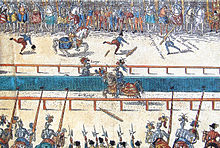Gabriel de Lorges, Count of Montgomery
Gabriel de Lorges | |
|---|---|
| Count of Montgomery Lord of Lorges and Ducey | |
 | |
| Born | Gabriel de Lorges 5 May 1530 Ducey, Normandy, France |
| Died | 26 June 1574 (aged 44) Place de Grève, Paris, France |
| Spouse(s) |
Isabeau de La Touche
(m. 1550) |
Gabriel de Lorges, Count of Montgomery, Lord of Lorges and Ducey (5 May 1530 – 26 June 1574), was a French nobleman of Scottish extraction and captain of the Scots Guard of King Henry II of France. He is remembered for mortally injuring Henry II in a jousting accident and subsequently converting to Protestantism, the faith that the Scots Guard sought to suppress. He became a leader of the Huguenots.[1] In French-language contexts, his name is spelled Montgommery.
Career
[edit]On 30 June 1559, during a jousting match to celebrate the Peace of Cateau Cambrésis between Henry II and his longtime Habsburg enemies, and two major marriages, namely that of Marguerite, the king's sister, with the Duke of Savoy Emmanuel-Philibert, and that of Elisabeth, the king's eldest daughter, with Philip II, king of Spain, a splinter of wood from Montgomery's shattered lance pierced Henry's eye and entered his brain, fatally injuring him. From his deathbed Henry absolved Montgomery of any blame, before dying on 10 July 1559. However, finding himself disgraced, Montgomery retreated to his estates in Normandy.[1] There he studied theology and converted to Protestantism,[1] making him an enemy of the state.


During the First War (1562–63) he fought for the Huguenots, capturing Bourges and leading several campaigns in his native Normandy. He led the defense of Rouen, and escaped the city just as it fell to the enemy.
He remained in France after the Peace of Amboise brought an end to the fighting. He took up arms again in 1567 when the wars of religion were renewed, and served under Condé in the major campaigns of 1567, 1568, and 1569.
Shortly after Condé's death at Jarnac in March 1569, Montgomery was tasked with restoring Jeanne d'Albret, the Huguenot queen of Navarre, to her territories in Béarn, which had been conquered by Catholic forces. He led a rapid campaign, which resulted in the destruction of a Catholic army at Orthez in August 1569.
Montgomery then, in early January, linked up with the survivors of the disastrous battle of Moncontour. The combined army, led by Coligny and the young princes of Condé and Navarre, fought the Catholics to a standstill at Arnay-le-Duc and imposed a favorable peace on the Crown.
He was one of the few leaders to survive the St. Bartholomew's Day massacre[1] after a wounded Huguenot swam across the Seine to warn him that rioting had begun.[1] A price was put on his head, but he managed to escape to England. The queen mother, Catherine de' Medici, asked Queen Elizabeth I for his extradition, but Elizabeth refused.

Montgomery returned to France with a fleet in an attempt to relieve the Siege of La Rochelle in 1573.[1] The following year he attempted an insurrection in Normandy, but was captured, taken to Paris,[2] and sentenced to death. On 26 June 1574, as he was about to be beheaded,[1] Montgomery was informed that a royal edict had proclaimed that his property would be confiscated and his children deprived of their titles.
A freely adapted version of Montgomery's life is told in Alexandre Dumas' novel The Two Dianas (1846–47), and he appears as a central character in Johann August Apel's story "Klara Mongomery" in the Gespensterbuch (1811).
Marriage and issue
[edit]He married (1550) Isabeau de La Touche (died 1593), by whom he had four sons and four daughters:
Sons
[edit]- Jacques I de Montgomery (1551–1560)
- Gédéon de Montgomery (died 1596)
- Gilles de Montgomery (1558–1596)
- Gabriel II de Montgomery (1565–1635), who built the Château de Ducey, and was father to six children:
- Louise de Montgomery
- Gabriel III de Montgomery (1595–1635)
- Suzanne de Montgomery
- Louis I de Montgomery (1601–1682)
- Jean de Montgomery (1605–1694)
- Jacques III de Montgomery (1609–1682)
Daughters
[edit]- Suzanne de Montgomery
- Elisabeth de Montgomery
- Claude de Montgomery
- Roberte de Montgomery, wife of Gawen Champernowne (died 1591) of Dartington in Devon, by whom she had issue. In 1582 she divorced him for adultery and in 1595 married Thomas Horner of Cloford.[3]
Notes
[edit]- ^ a b c d e f g Chisholm, Hugh, ed. (1911). . Encyclopædia Britannica. Vol. 18 (11th ed.). Cambridge University Press. p. 783.
- ^ Gilman, D. C.; Peck, H. T.; Colby, F. M., eds. (1905). . New International Encyclopedia (1st ed.). New York: Dodd, Mead.
- ^ Vivian, Lt.Col. J. L., (Ed.) The Visitations of the County of Devon: Comprising the Heralds' Visitations of 1531, 1564 & 1620, Exeter, 1895, p. 163, pedigree of Champernowne
References
[edit]- Landurant, Alain (1988). Montgommery le régicide. Paris: Tallandier. ISBN 2-235-01773-8.
- Setton, Kenneth M. (1984). The Papacy and the Levant (1204–1571), Volume III: The Sixteenth Century to the Reign of Julius III. Philadelphia: The American Philosophical Society. ISBN 0-87169-161-2.
- 16th-century executions by France
- 1530 births
- 1574 deaths
- Converts to Calvinism from Roman Catholicism
- Counts of Montgomery
- Executed French people
- French people of Scottish descent
- French people of the French Wars of Religion
- French refugees
- French soldiers
- Garde Écossaise officers
- Huguenots
- People executed by France by decapitation
- People executed for treason
- Court of Henry II of France
